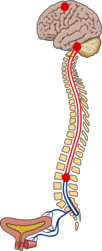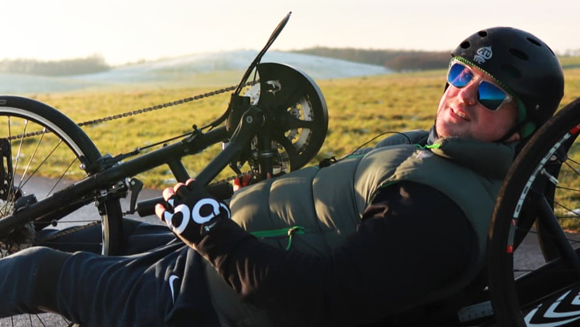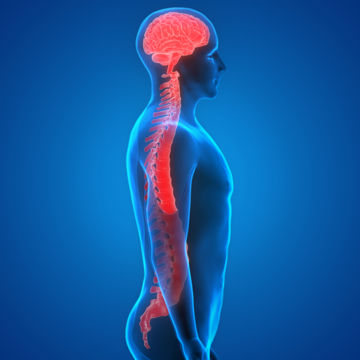
Spinal cord injury (SCI) means damage to the spinal cord itself, sometimes in combination with damage to the nerve roots in the lowest section of the spinal cord.
What is the Spinal Cord and What Does it do?
The spinal cord is about as thick as a finger and lies in a fluid-filled canal in the vertebral column, which is the spine itself. The spinal cord contains cells that send and receive signals from the entire body. Thanks to these signals, we can, among other things, move our arms, legs, and other muscles in the body. These signals also control the body’s ability to empty the bladder and bowel.
Bladder and Bowel Problems in Spinal Cord Injury
If the spinal cord is damaged, the ability for the signals to travel back and forth is broken, resulting in problems when emptying both the bladder and the bowel.
Different Levels of Injury
There are different types of damage to the spinal cord. The higher up in the spinal cord an injury occurs, the more muscles are affected. In the case of paraplegia, the spinal cord is so damaged that the legs are affected. In the case of tetraplegia, both arms and legs are affected.
Complete spinal cord damage means that the spinal cord has been completely cut off. No signals can travel along it, which means that all feeling and ability to move is gone below the point of injury.
If the damage is incomplete, you experience a certain loss of the ability to control your muscles. But some signals will still come through. If you have some motor control in your hands and arms, you will most likely be able to choose self-catheterization as a bladder-emptying option and bowel irrigation for the prevention of bowel symptoms.
The anatomical location and severity of your injury will determine the type of bladder and bowel condition you will have. Simply put, the higher the injury is located, the more serious it may be for your health. This is due to loss of steering and control from the brain associated with urination and bowel emptying.
A high SCI (chest or up) would typically result in the limitation of movement of the muscles surrounding your bladder and bowel, resulting in the following symptoms:
- A reflex center takes over and the bladder and sphincter (which is the muscle that regulates the flow of urine from your bladder) work against each other building up high pressure in the bladder.
- Risk of urine going back up to the kidneys, a dangerous condition that can potentially destroy them.
- Increased risk of infection and incontinence.
First-line treatment is to reduce bladder pressure with pharmaceuticals and empty the bladder with Intermittent Catheterization (IC).
As for the bowel, a high SCI will often result in a reflex bowel that has the following symptoms:

- Slower colon transit times, up to double the ‘normal healthy’ transit time are common. This will lead to constipation and fecal impaction.
- Loss of sensation when the bowel is full. The message between the bowel and the central nervous system (CNS) usually telling the bowel that it is full is not received.
- The bowel will continue to empty when stimulated.
- A high rectal pressure.
- The muscle controlling the opening and closing of the anus stays tight.
- When the bowel gets full, it empties automatically which can cause accidents.
A low SCI would typically result in the following symptoms:
- Loss of muscle tone in the bladder and sphincter.
- Missing contraction of the bladder muscle (due to the fact that this region is responsible for reflex bladder emptying).
- Damage below the reflex center affects some or all of the nerves in this region, depending on the type of damage (lesion).
- If all nerve roots are affected, the bladder is unable to demonstrate any contraction.
- If some nerve fibers are affected (incomplete lesions), filling of the bladder may be registered, but activation of the detrusor and/or sphincter (the muscles that control the emptying of urine from your bladder) is not possible.
- Retention or incomplete emptying, urinary tract infections and (overflow) incontinence.
The first line of treatment is intermittent catheterization. It is also worth mentioning that recent studies indicate that up to 30% of those who lose control of their bladder, may regain function again sometime after the injury.
A low SCI would also typically result in a flaccid bowel, with the following symptoms:
- Loss of sensation when the bowel is full
- The bowel will not fully empty, even when stimulated. This is because the SCI has damaged the pathways from the bowel into the reflex center in the spine, i.e. there cannot be any reflex action
- The rectal pressure is low
- Possibility of bowel leakage, i.e. fecal incontinence
Managing Your Bladder and Bowel if You Have a Spinal Cord Injury
Bowel problems with SCI can have a great impact on quality of life and is important to manage. There are different management options to prevent symptoms of constipation and bowel leakage. Bowel irrigation is an option that you can discuss with your healthcare provider and read more about here.
Having a spinal cord injury can affect the control you have over your bladder, which can be a worry to manage. There are different ways to help with bladder emptying, to improve control over your bladder, and to avoid infections or complications.
Intermittent catheterization (IC) is an option that you can discuss with your health provider and read more about here.
Since there is a close connection between the bladder and bowel, and problems arising in one area might also affect the other, it is important to manage both.
-
Bladder and Bowel Dysfunction
What is bladder and bowel dysfunction and how do they correlate with each other? In a lot of cases, bladder and bowel symptoms coexist side by side and interact. Here we explore why.

-
What I Need From a Catheter as a Parathlete
Professional wheelchair tennis player, 32-year-old Austrian Tina Pesendorfer travels a lot. With a busy training schedule, she's glad catheterizing no longer distracts her.

-
How I Keep My Positive Outlook After a Spinal Cord Injury
We spoke to Layth who shares his story about sustaining a spinal cord injury, how he keeps a positive outlook on life and how he uses Navina to manage his bowel care.

For Healthcare Professionals
-
Spinal cord injury (SCI) - bladder and bowel function
key:global.content-type: Article
The majority of individuals with SCI experience significant symptoms related to neurogenic bowel dysfunction. For example, 42% experience constipation and as many as 77% experience fecal incontinence.

-
Neurogenic bladder dysfunction
key:global.content-type: Article
Neurogenic bladder is a disorder of the lower urinary tract created by damage to or diseases of the nervous system.

-
Long-term safety of intermittent catheterization
key:global.content-type: Article
Single-use hydrophilic catheters were developed in the early eighties to address long-term complications of intermittent catheterization that came about when people reused plastic catheters with add-on lubrication.

-
Teaching Intermittent Catheterization
key:global.content-type: Course
Learn about the function of the bladder, the anatomy and physiology of the urinary tract and get treatment options for incomplete bladder emptying.
